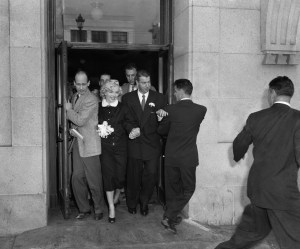Marilyn Monroe and Joe DiMaggio’s whirlwind romance may have been short-lived, but it remains one of the most talked-about relationships in Hollywood history.
As anticipation builds for Netflix’s upcoming film “Blonde,” a fictional portrayal of Monroe’s life, the spotlight once again shines on her tumultuous connection with DiMaggio, from their brief marriage to a lasting friendship.
Their paths crossed in 1952 when retired baseball star DiMaggio sought an introduction to Monroe, who was then a rising Hollywood starlet.
Initially hesitant, Monroe feared DiMaggio would embody the stereotype of an arrogant athlete, as revealed in her autobiography “My Story,” penned by Ben Hecht.
Despite residing on opposite coasts – Monroe in the West and DiMaggio in the East – the couple pursued a long-distance relationship that inevitably captured public attention.
In January 1954, amidst fanfare and media frenzy, they exchanged vows at San Francisco City Hall, opting for an unconventional elopement due to their prior marriages.
Dressed in a dark brown suit with a white fur collar and black pumps, Monroe defied tradition as DiMaggio stood by her side in a simple suit during their nuptials.
Their bond, marked by a shared desire for children despite Monroe’s health challenges, faltered under DiMaggio’s possessiveness and Monroe’s demanding filming schedule.
A pivotal moment arose during their honeymoon in Japan when Monroe’s commitment to entertain American troops in South Korea strained their relationship further, revealing cracks in their union.
Tensions peaked during the filming of “The Seven Year Itch,” culminating in a public dispute triggered by director Billy Wilder’s orchestrated scene that drew cheers from onlookers, much to DiMaggio’s dismay.
The marriage unraveled swiftly, with Monroe filing for divorce in October 1954, citing “mental cruelty” after just nine months of matrimony.
Monroe’s subsequent marriage to playwright Arthur Miller also ended in divorce in 1961, leading her to face personal struggles and health issues.
Amidst surgeries and hospitalizations for depression, Monroe found solace in rekindling a friendship with DiMaggio, who supported her through challenging times.
Following Monroe’s tragic death from a barbiturate overdose in 1962, DiMaggio privately mourned her loss, maintaining a poignant tribute by placing red roses at her crypt multiple times weekly for two decades.
Refusing to publicly discuss Monroe or remarry, DiMaggio honored her memory with unwavering devotion, symbolizing a love that transcended time and tragedy.


